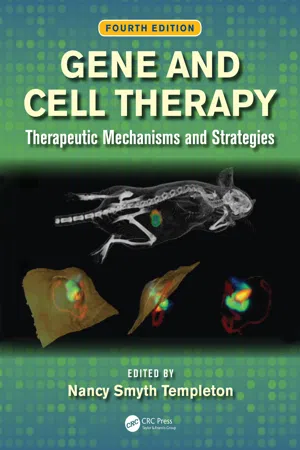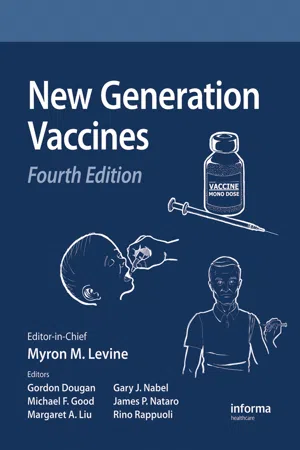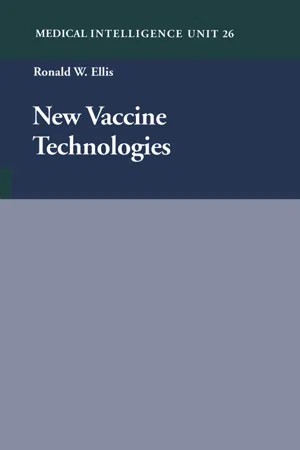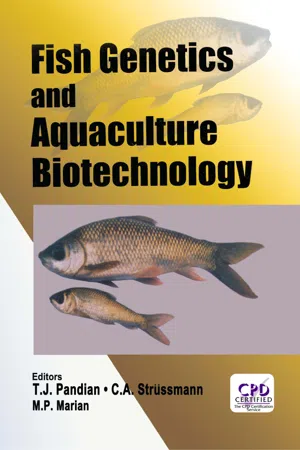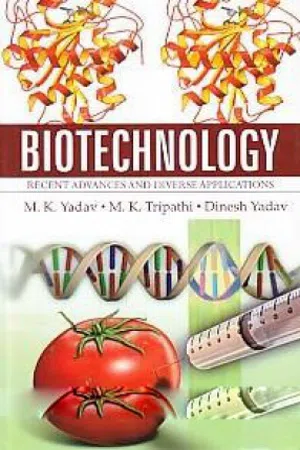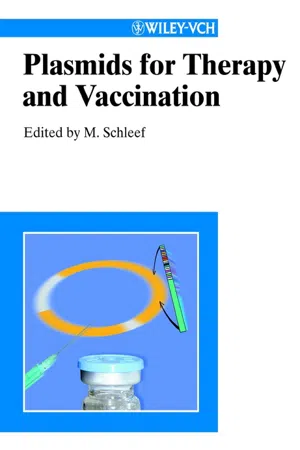Biological Sciences
DNA Vaccine
A DNA vaccine is a type of vaccine that uses genetically engineered DNA to stimulate an immune response against a specific pathogen. The DNA encoding the antigen is injected into the body, where it is taken up by cells and used to produce the antigen, triggering an immune response. This approach has the potential to be more stable and cost-effective than traditional vaccines.
Written by Perlego with AI-assistance
Related key terms
1 of 5
6 Key excerpts on "DNA Vaccine"
- eBook - PDF
Gene and Cell Therapy
Therapeutic Mechanisms and Strategies, Fourth Edition
- Nancy Smyth Templeton(Author)
- 2015(Publication Date)
- CRC Press(Publisher)
In addition, any sim-plification in manufacturing and increase in vaccine product stability are likely to positively impact vaccine production for the developing world. These advantages are the promise of DNA Vaccines. 33.2 DNA VaccineS 33.2.1 C ONCEPTS OF DNA V ACCINES Pioneering work from a small number of laboratories, includ-ing that of the authors, has demonstrated that the injection of DNA plasmid containing foreign genes encoding proteins of a pathogen or cancer antigens directly into a host can 836 Gene and Cell Therapy: Therapeutic Mechanisms and Strategies give rise to specific immunity. This injection results in the subsequent expression of the foreign genes in a host and the presentation of the specific encoded proteins to the immune system (Figure 33.1) [4]. DNA Vaccine constructs can be pro-duced as small circular vehicles or plasmids. These plasmids are constructed with a promoter site, which starts the tran-scription process, an antigenic DNA sequence, and a messen-ger RNA stop site containing the poly A tract necessary for conversion of the messenger RNA sequence into the antigen protein by the ribosomal protein manufacturing machinery (Figure 33.2). The concept of genetic immunization provides that both DNA and RNA that encode specific proteins can be used to generate specific immune responses. Because DNA and RNA are both nucleic acids, the term nucleic acid vac-cine has also been used to describe this process. 33.2.2 H ISTORY OF DNA V ACCINES The ability of genetic material to deliver genes for therapeu-tic purposes and its use in gene therapy has been appreciated for some time. Early experiments describing DNA inoculation into living cells were DNA transfer experiments performed by a number of investigators in the 1950s as well as 1960s [5–7]. These reports describe the ability of DNA preparations iso-lated from tumors or viral infections to induce tumors or virus infection following injection into animals. - eBook - PDF
- Myrone M. Levine, Myron M. Levine, Gordon Dougan, Michael F. Good, Margaret A. Liu, Gary J. Nabel, James P. Nataro, Rino Rappuoli, Myrone M. Levine, Myron M. Levine, Gordon Dougan, Michael F. Good, Gary J. Nabel, James P. Nataro, Rino Rappuoli, Myrone M. Levine, Myron M. Levine, Gordon Dougan, Michael F. Good, Gary J. Nabel, James P. Nataro, Rino Rappuoli(Authors)
- 2016(Publication Date)
- CRC Press(Publisher)
This chapter will review the properties of DNA Vaccines, giving examples of the various protective immune responses, then provide an update on advances in the technology which are leading to increased potency of DNA Vaccines either used by themselves or in conjunction with other vaccine modalities or technologies. DNA Vaccines are comprised of plasmids of DNA encod-ing antigens. These antigens can be from pathogens, tumors, or even host proteins, in the case of vaccines for the therapy of autoimmune diseases. They thus differ from traditional vac-cines in not being made of an actual pathogen or of a purified or recombinant protein of a pathogen, and by being synthe-sized in vivo in the vaccinee following immunization. The plasmids utilize a promoter active in the recipient rather than a bacterial promoter. This in situ synthesis of the antigen results in potential advantages from a vaccine standpoint for both humoral and cellular immune responses. Cellular Immune Responses Indeed, DNA Vaccines were initially developed because by enabling a cell to produce an antigen in the cell, the antigen can then enter the major histocompatibility complex (MHC) class I processing pathway (which exogenously given protein antigens usually cannot) with the resultant generation of MHC class I-restricted CD8 þ T cells. As these cytolytic T-cell responses are thought to play a crucial role in the defense against, and recovery from, diseases due to viruses, tumors, and certain parasites and intracellular pathogens, many vac-cines under development are focusing upon technologies that can stimulate such cellular responses. Demonstration of the ability of DNA Vaccines to generate effective cellular immune responses in vivo provided the first proof of the capabilities of the technology (1) by showing that a DNA Vaccine encoding the internal conserved nucleoprotein of influenza virus could pro-tect mice against death following challenge with a heterosub-typic strain of influenza. - eBook - PDF
- Ronald W. Ellis(Author)
- 2001(Publication Date)
- CRC Press(Publisher)
C hapter 14 DNA Vaccines Daniel E. McCallus, Catherine J. Pachuk, Shaw-guang Lee and C. Satishchandran Introduction R esearch into the use of DNA Vaccines has shown that this mode of immunization has much potential for widescale application. The ability to elicit an immune response by injection of DNA encoding the gene for the protein-antigen of interest has been dem onstrated by a variety of methods. The genes may be introduced into eukaryotic cells by viral or bacterial vectors or through uptake of naked or complexed plasmid DNA. All allow an exog enous gene to be transcribed inside the host (vaccinees) cell and allow the presentation of the expressed protein to the immune system in a manner that will generate a potentially protective response. This review will describe the methods by which DNA Vaccines are delivered to the cells and how the genes are expressed and presented to the immune system. Other important issues such as the safety and manufacturing of DNA Vaccines will also be addressed. Vaccination with DNA is a recent technology possessing distinct advantages over traditional vaccines (killed or attenuated organisms) and the more recendy-derived subunit vaccines. DNA Vaccines, like attenuated vaccines, are able to induce both cellular and humoral responses, while subunit vaccines typically elicit only humoral responses. The risk o f revertants that is present with attenuated viral or bacterial vaccines are not an issue with DNA Vaccines. In addition, plasmid DNA Vaccines also may have advantageous stability properties and should be able to withstand worldwide transport to a greater extent as compared to their traditional counterparts. Plasmid DNA can also be easily manipulated using standard laboratory tech niques, allowing for the creation of a “backbone” plasmid that can incorporate a potentially limidess number of different genes. The resulting plasmids can be readily scaled up to produce large quantities of vaccine stocks. - eBook - PDF
- T J Pandian(Author)
- 2005(Publication Date)
- CRC Press(Publisher)
Generally, DNA Vaccines consist of a bacterial plasmid with a strong promoter-usually of viral origin-the gene of interest and a poly-adenylation or transcriptional termination sequence. 1his plasmid, as amplified in bacteria, is purified, dissolved in a saline solution and then simply injected into the host. The DNA plasmid is taken up by host cells where the encoded protein is created (Donnelly et al. 1997). 1his expressed protein acts as a vaccine. Aquacultllre, or the farming of aquatic animals, is a rapidly growing industry. The increased demand for fishery products, due to health awareness of consumers and the decline or near stagnation of the natural harvests, have largely contributed to this rapid growth (Meyer, 1991). However, the aquaculture industry needs to augment its global production and efficiency to meet the demand, which is expected to be 10-30% higher than current levels by 2010 AD. A major constraint to the development of this industry is the outbreak of infectious diseases. Although currently available vaccines offer the most efficient way to control infectious pathogens, there are still several important diseases--mainly of viral and parasitic origin-for which no prophylactic treatment exists (Schnick et al., 1997; Heppell and Davis, 2000). The development of cheap and effective vaccines for the prevention of infectious diseases in finfish has been proved to be a difficult task (Evelyn, 1997; Leong et al., 1997). Recently, several research groups have exhibited the potential of DNA Vaccines in aquaculture. Several characteristics of nucleic acid immunization make this technology especially attractive for the prevention of diseases in aquaculture (Leong et al. 1997). Table 10.1 summarizes a brief history of the development of DNA Vaccines in aquaculture. DNA Vaccine technology in aquaculture has so far been focused on viral vaccines only. - Yadav, M K(Authors)
- 2021(Publication Date)
- Biotech(Publisher)
2.2 Advantages with DNA Vaccines DNA Vaccines have many advantages and potentially more widespread applications compared to other types of vaccine technologies (Srivastava and Liu, 2003). First plasmid DNA is very stable compared to many other vaccines, making preparation, handling, and storage and worldwide distribution easier. Second DNA Vaccines are considered to have very few side effects as compared to attenuated live virus vaccines. Third DNA vectors do not contain viral proteins that potentially could result in undesired effects such as down regulation of immune responses, or acting as decoys for the immune system by inducing strain specific immune responses. Fourth, the use of DNA plasmids rather than viral vectors eliminates the problem of pre-existing antibodies to viral proteins and potential induction of anti vector immunity when performing repetitive vaccination. Moreover, most DNA Vaccines differ only by inserted antigen encoding gene, making manufacturing and purification a similar and easy process for all plasmid vaccines. In contrast, unique manufacturing is required for each type of cell based, recombinant protein or viral vaccine. It provides prolonged antigen expression that continuously stimulates the immune system. Thus, DNA Vaccines are good candidates for the development of future cancer vaccines as they can easily and safely deliver genes encoding tumor antigens, to which potent immune responses can be induced (Ross, 2006). This ebook is exclusively for this university only. Cannot be resold/distributed. 2.3 Efficacy of DNA Vaccine against Cancer The feasibility of using DNA Vaccines as an immunotherapeutic approach against cancer was demonstrated in 1993 and then since then been confirmed in several animal models. Several phase 1 clinical trials investigating DNA vaccination against cancer have been published.- eBook - PDF
- Martin Schleef(Author)
- 2008(Publication Date)
- Wiley-Blackwell(Publisher)
This has not been experimentally verified; the available experi- mental data indicate that suboptimal immunization can prime responses that are revealed by boost injections, induction of autoimmune responses (e.g., autoantibodies against cytokines). This occurs but is also observed in the course of, e. g., chronic infections, extensive immune-mediated destruction of tissue transfected in vivo. This may actu- ally be of advantage to delete genetically altered cells. 10 Future perspectives DNA immunization is an exciting new option for designing vaccines that effi- ciently stimulate T cell responses. Only a few years have passed since its first de- scription in 1992 but many experimental DNA Vaccines have moved from preclini- cal animal models into clinical trials. The main factors that contribute to the suc- cess of a DNA Vaccine are schematically shown in Figure 3 . These are - - its delivery, and - Most principles of the design of plasmid vectors, cloning of antigens of interest and codelivery of immuno-modulators have been defined. The choice of the site for inoculation, the conditioning of the injected tissue, the age of the vaccinated subject, and the type of preexisting immunity are factors that have to be taken into account but are readily controlled in vaccination protocols. The major chal- lenge is to find better ways to deliver the DNA Vaccine, including the techniques used for inoculation, the packaging of the DNA Vaccine, and the use of low doses of DNA in such vaccines. These problems are largely unresolved and will de- cide on the eventual success of this vaccination strategy. the design of the DNA Vaccine, conditions of the treated subject. 60 Jorg Reimann et a/. I 1. Expression vector 2. Plasmidencoded antigen I 3. Co-delivery of immuno- modulators B I DNA delivery I 4. Delivery technique 5. Packaging of DNA 6. Dose of plasmid DNA inoculated C I I /,' I ; 7. Site of injection 8. Condition of tissue chosen for DNA immunization 9.
Index pages curate the most relevant extracts from our library of academic textbooks. They’ve been created using an in-house natural language model (NLM), each adding context and meaning to key research topics.
